Ryobi P4360 Owner's Manual
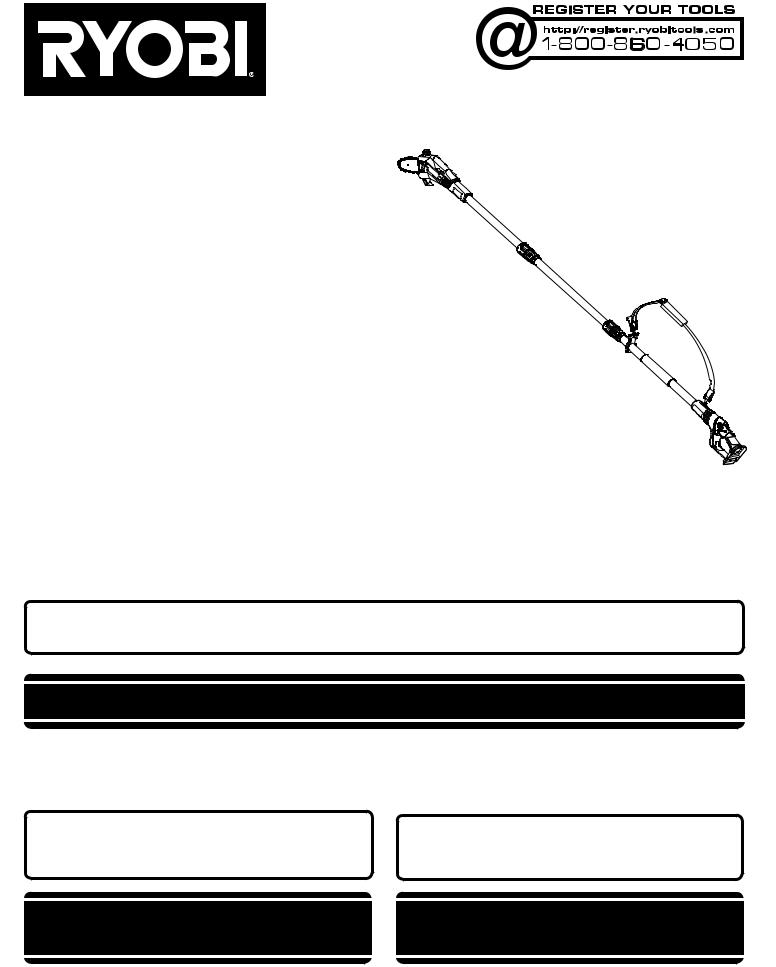
OPERATOR’S MANUAL
MANUEL D’UTILISATION MANUAL DEL OPERADOR
18 VOLT POLE SAW
scie de manche 18 V Sierra DE Pértiga DE 18 V
P4360
ACCEPTS ALL ONE+ BATTERY PACKS
BATTERIES AND CHARGERS SOLD SEPARATELY
COMPATIBLE AVEC TOUS LE PILES ONE+
PILES ET CHARGEUR VENDUS SÉPARÉMENT
ACEPTA TODOS LOS PAQUETES DE BATERÍAS ONE+
LAS BATERÍAS Y EL CARGADOR SE VENDEN POR SEPARADO
ALL VERSIONS
TOUTES LES VERSIONS / TODAS LAS VERSIONES
Your pole saw has been engineered and manufactured to our high standard for dependability, ease of operation, and operator safety. When properly cared for, it will give you years of rugged, trouble-free performance.
 WARNING: To reduce the risk of injury, the user must read and understand the operator’s manual before using this product.
WARNING: To reduce the risk of injury, the user must read and understand the operator’s manual before using this product.
SAVE THIS MANUAL FOR FUTURE REFERENCE
Cette scie de manche a été conçu et fabriqué conformément à nos strictes normes de fiabilité, simplicité d’emploi et sécurité d’utilisation. Correctement entretenu, cet outil vous donnera des années de fonctionnement robuste et sans problème.
 AVERTISSEMENT : Pour réduire les risques de blessures, l’utilisateur doit lire et veiller à bien comprendre le manuel d’utilisation avant d’employer ce produit.
AVERTISSEMENT : Pour réduire les risques de blessures, l’utilisateur doit lire et veiller à bien comprendre le manuel d’utilisation avant d’employer ce produit.
Su sierra de pértiga ha sido diseñado y fabricado de conformidad con nuestras estrictas normas para brindar fiabilidad, facilidad de uso y seguridad para el operador. Con el debido cuidado, le brindará muchos años de sólido funcionamiento y sin problemas.
 ADVERTENCIA: Para reducir el riesgo de lesiones, el usuario debe leer y comprender el manual del operador antes de usar este producto.
ADVERTENCIA: Para reducir el riesgo de lesiones, el usuario debe leer y comprender el manual del operador antes de usar este producto.
CONSERVER CE MANUEL POUR |
GUARDE ESTE MANUAL PARA |
FUTURE RÉFÉRENCE |
FUTURAS CONSULTAS |

TABLE OF CONTENTS |
|
TABLE DES MATIÈRES / ÍNDICE DE CONTENIDO |
|
Introduction........................................................................................................................................ |
2 |
Introduction / Introducción |
|
important Safety Instructions......................................................................................................... |
3-4 |
Instructions importantes concernant la sécurité / Instrucciones de seguridad importantes |
|
Specific Safety Rules..................................................................................................................... |
4-5 |
Règles de sécurité particulières / Reglas de seguridad específicas |
|
Symbols......................................................................................................................................... |
6-7 |
Symboles / Símbolos |
|
Features......................................................................................................................................... |
8-9 |
Caractéristiques / Características |
|
Assembly..................................................................................................................................... |
9-11 |
Assemblage / Armado |
|
Operation................................................................................................................................... |
11-14 |
Utilisation / Funcionamiento |
|
Maintenance.............................................................................................................................. |
15-19 |
Entretien / Mantenimiento |
|
Troubleshooting............................................................................................................................... |
19 |
Dépannage / Corrección de problemas |
|
Warranty........................................................................................................................................... |
20 |
Garantie / Garantía |
|
Parts Ordering and Service................................................................................................ |
Back Page |
Commande de pièces et réparation / Pedidos de piezas y servicio.......................................................... |
Page arrière / Pág. posterior |
introduction |
|
Introduction / Introducción |
|
This product has many features for making its use more pleasant and enjoyable. Safety, performance, and dependability have been given top priority in the design of this product making it easy to maintain and operate.
* * *
Ce produit offre de nombreuses fonctions destinées à rendre son utilisation plus plaisante et satisfaisante. Lors de la conception de ce produit, l’accent a été mis sur la sécurité, les performances et la fiabilité, afin d’en faire un outil facile à utiliser et à entretenir.
* * *
Este producto ofrece numerosas características para hacer más agradable y placentero su uso. En el diseño de este producto se ha conferido prioridad a la seguridad, el desempeño y la fiabilidad, por lo cual se facilita su manejo y mantenimiento.
Page 2

important safety instructions
 WARNING:
WARNING:
Read and understand all instructions. Failure to follow all instructions listed below may result in electric shock, fire, and/or serious personal injury.
read all instructions
For safe operation, read and understand all instructions before using this product. Be familiar with all controls and proper use of the machine. Follow all safety instructions. Failure to follow all safety instructions listed below, can result in serious personal injury.
Do not allow children or untrained individuals to use this unit.
Thoroughly inspect the area where the equipment is to be used and remove all foreign objects.
Wear eye protection with side shields, which is marked to comply with ANSI Z87.1, along with head protection when operating this equipment.
Dress Properly — Wear heavy long pants, long sleeves, boots, and gloves. Do not wear loose fitting clothing, short pants, sandals, or go barefoot. Do not wear jewelry of any kind.
Secure long hair above shoulder level to prevent entanglement in moving parts.
Keep Children Away — Keep all bystanders, children, and pets at least 50 ft. away.
Stay Alert — Watch what you are doing; use common sense. Do not operate this unit when you are tired, ill, upset, or under the influence of alcohol, drugs, or medication.
Do not operate in poor lighting.
Use Safety Glasses — Always use face or dust mask if operation is dusty.
Disconnect Appliance — Remove battery from appliance when not in use, before servicing , when changing accessories such as bar chain.
Don’t Overreach — Keep proper footing and balance at all times. Overreaching can result in loss of balance or exposure to hot surfaces.
Keep all parts of your body away from any moving part.
Inspect the unit before each use for loose fasteners, etc. Replace any damaged parts before use.
When not in use, product should be stored indoors in a dry, locked up place — out of the reach of children.
Use only original manufacturer’s replacement parts. Failure to do so may cause poor performance, possible injury, and will void your warranty.
Do not, under any circumstance, use any attachment or accessory on this product which was not provided with the product or identified as appropriate for use with this product in the operator’s manual.
Avoid Dangerous Environments — Do not use the product in damp or wet locations. Do not use in rain.
Use the Right Appliance — Do not use the product for any job except that for which it is intended.
Do not operate from steps, a ladder, rooftop, tree, or unstable support. Stable footing on a solid surface enables better control of the product in unexpected situations.
Do not force the product. It will do the job better and with less likelihood of a risk of injury at the rate for which it was designed.
DANGER — Keep hands away from cutting area. Keep both hands on handles when power is on.
CAUTION — Blade coasts after being turned off.
Do not grasp the exposed cutting blades or cutting edges when picking up or holding the product.
Page 3 — English

important safety instructions
Check Damaged Parts — Before further use of the product, a guard or other part that is damaged should be carefully checked to determine that it will operate properly and perform its intended function. Check for alignment of moving parts, binding of moving parts, breakage of
parts, mounting, and any other condition that may affect its operation. A guard or other part that is damaged should be properly repaired or replaced by an authorized service center unless indicated elsewhere in this manual.
SPECIFIC SAFETY RULES
Kickback is a dangerous reaction that can lead to serious injury. Kickback may occur when the moving chain contacts an object at the upper portion of the tip of the guide bar or when the wood closes in and pinches the chain in the cut. Contact at the upper portion of the tip of the guide bar can cause the chain to dig into the object and stop the chain for an instant. The result is a lightning-fast, reverse reaction which kicks the guide bar up and back toward the operator. If the chain is pinched along the top of the guide bar, the guide bar can be driven rapidly back toward the operator, which can cause loss of control and may result in serious injury. Do not rely exclusively upon the safety devices built into the product.
With a basic understanding of kickback, you can reduce or eliminate the element of surprise. Sudden surprise contributes to accidents.
Use pole saw for cutting wood only. Do not use for cutting non-wood items.
Make sure that the area in which you are cutting is free from obstructions. Do not let the nose of the guide bar contact a log, branch, fence, or any other obstruction while you are operating the unit. Have a planned retreat path.
Cut only when visibility and light are adequate for you to see clearly.
To protect yourself from electrocution, do not operate within 50 feet of overhead electrical lines.
Before starting the motor, make sure the chain is not contacting any object.
To protect yourself from falling branches, do not stand directly under the branch or limb being cut. This unit should not be held at an angle over 60° from ground level.
Turn off the motor and make sure cutting attachment has stopped before setting unit down.
Follow the sharpening and maintenance instructions for the saw chain.
Use only the replacement guide bars and low kickback chains specified for the unit.
Do not operate the saw with one hand! Serious injury to the operator, helpers, bystanders, or any combination of these persons may result from one hand operation. This saw is intended for two-handed use.
Use extreme caution when cutting small-sized brush and saplings because slender material may catch the saw chain and be whipped toward you or pull you off balance.
When cutting a limb that is under tension, be alert for spring back so that you will not be struck when the tension in the wood fibers is released.
To avoid accidental starting, never carry the unit with the battery installed or with your finger on the switch trigger.
Maintain Product With Care — Keep cutting edge sharp and clean for best performance and to reduce the risk of injury. Follow instructions for lubricating and changing accessories. Inspect the battery charger cord periodically, and if damaged, have it replaced or repaired by an authorized service dealer.
Keep handles dry, clean, and free from oil and grease.
Page 4 — English

SPECIFIC SAFETY RULES
Service on the product must be performed by qualified repair personnel only. Service or maintenance performed by unqualified personnel could result in injury to the user or damage to the product.
nBattery operated units do not have to be plugged into an electrical outlet; therefore, they are always in operating condition. Be aware of possible hazards even when unit is not operating.
nRemove the battery pack from the pole saw before cleaning, servicing, storing, removing material from the unit, changing accessories such as the bar and chain, or when not in use.
nA battery pack must be recharged only with the specified charger for the battery pack. A charger that may be suitable for one type of battery pack may create a risk of fire when used with another battery pack. Use battery pack only with charger listed.
nFor use with 18V nickel-cadmium and 18 V lithium-ion battery packs, see tool/appliance/ battery pack/charger correlation supplement 987000-432.
nTo reduce the risk of explosion and possible injury, do not place battery units or their batteries near fire or heat.
nDo not open or mutilate the battery pack. Released electrolyte is corrosive and may cause damage to the eyes or skin. It may be toxic if swallowed.
nDo not charge appliance in rain, or in wet locations.
nDo not charge unit in a damp or wet location. Following this rule will reduce the risk of electric shock.
nDo not dispose of batteries in a fire. The cell may explode. Batteries should be recycled, consult your local waste authority for information regarding available recycling and/or disposal options.
nExercise care in handling batteries in order not to short terminals. When battery pack is not in use, keep it away from other metal objects like: paper clips, coins, keys, nails, screws, or other small metal objects that can make a connection from one terminal to another. Shorting the battery pack terminals together may cause sparks, burns, or a fire.
Save these instructions. Refer to them frequently and use them to instruct others who may use this product. If you loan someone this product, loan them these instructions also to prevent misuse of the product and possible injury.
SAVE THESE INSTRUCTIONS
Page 5 — English

SYMBOLS
Some of the following symbols may be used on this product. Please study them and learn their meaning. Proper interpretation of these symbols will allow you to operate the product better and safer.
SYMBOL |
NAME |
EXPLANATION |
|
Safety Alert Symbol |
Indicates a potential personal injury hazard. |
|
|
To reduce the risk of injury, user must read and |
|
Read Operator’s Manual |
understand operator’s manual before using this |
|
|
product. |
|
Wear Eye and Head |
Always wear eye protection with side shields |
|
marked to comply with ANSI Z87.1, along with |
|
|
Protection |
|
|
head protection. |
|
|
|
|
|
Wet Conditions Alert |
Do not expose to rain or use in damp locations. |
|
Gloves |
Wear non-slip, heavy-duty protective gloves when |
|
handling the pole saw and the blade. |
|
|
|
|
|
Safety Footwear |
Wear non-slip safety footwear when using this |
|
equipment. |
|
|
|
|
|
Keep Tool Away from |
DANGER! Risk of electrocution! Keep tool 50 feet |
|
Electrical Lines/Keep |
away from electrical lines. Keep all bystanders at |
|
Bystanders Away |
least 50 ft. away. |
|
Electric Shock |
Failure to use in dry conditions and to observe safe |
|
practices can result in electric shock. |
|
|
|
|
|
No Hands Symbol |
Failure to keep your hands away from the blade will |
|
result in serious personal injury. |
|
|
|
|
|
|
This product uses lithium-ion or nickel-cadmium |
|
|
batteries. Local, state or federal laws may prohibit |
|
Recycle Symbols |
disposal of batteries in ordinary trash. Consult |
|
|
your local waste authority for information regarding |
|
|
available recycling and/or disposal options. |
V |
Volts |
Voltage |
|
Direct Current |
Type or a characteristic of current |
Page 6 — English

SYMBOLS
The following signal words and meanings are intended to explain the levels of risk associated with this product.
SYMBOL SIGNAL |
MEANING |
|
DANGER: |
Indicates an imminently hazardous situation, which, if not avoided, |
|
will result in death or serious injury. |
||
|
||
WARNING: |
Indicates a potentially hazardous situation, which, if not avoided, |
|
could result in death or serious injury. |
||
|
||
CAUTION: |
Indicates a potentially hazardous situation, which, if not avoided, |
|
may result in minor or moderate injury. |
||
|
(Without Safety Alert Symbol) Indicates important information not NOTICE: related to an injury hazard, such as a situation that may result in
property damage.
Page 7 — English
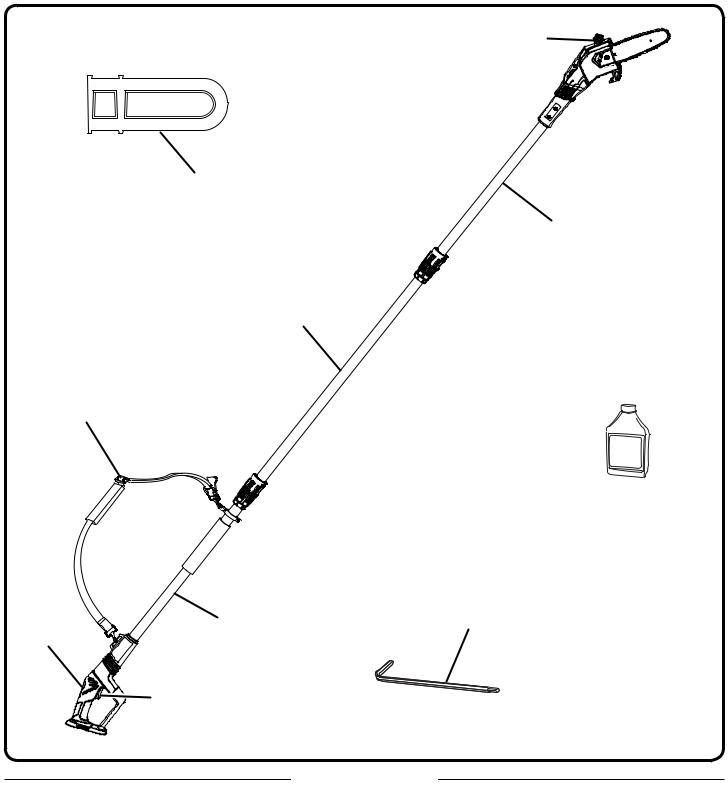
|
FEATURES |
PRODUCT SPECIFICATIONS |
|
Motor...................................................................................................................................... |
18 Volt DC |
Bar Length....................................................................................................................................... |
8 in. |
Cutting Capacity.............................................................................................................................. |
6 in. |
Chain Pitch..................................................................................................................................... |
3/8 in. |
Chain Type...................................................................................... |
Low Profile Skip Tooth Narrow Kerf |
Weight............................................................................................................................................. |
8 lbs. |
oil cap |
scabbard
intermediate POLE
shoulder harness
trigger |
HANDLE |
lock-out |
POLE |
|
switch |
|
trigger |
CUTTING HEAD
POLE
bar and chain  lubricant
lubricant 
hex key
Fig. 1
Page 8 — English

FEATURES
KNOW YOUR pole saw
See Figure 1.
The safe use of this product requires an understanding of the information on the product and in this operator’s manual as well as a knowledge of the project you are attempting. Before use of this product, familiarize yourself with all operating features and safety rules.
quick-view oil indicator
Semi-transparent bar lube reservoir that allows user to see when to add lubricant.
scabbard
The scabbard keeps the operator from coming in contact with the sharp blades when the tool is not in use. It also helps keep the blades from being nicked or damaged when the tool is in storage.
TRIGGER LOCK-OUT
The trigger lock-out prevents unintentional starting of the pole saw.
ASSEMBLY
UNPACKING
This product requires assembly.
nCarefully remove the product and any accessories from the box. Make sure that all items listed in the packing list are included.
 WARNING:
WARNING:
Do not use this product if any parts on the Packing List are already assembled to your product when you unpack it. Parts on this list are not assembled to the product by the manufacturer and require customer installation. Use of a product that may have been improperly assembled could result in serious personal injury.
nInspect the product carefully to make sure no breakage or damage occurred during shipping.
nDo not discard the packing material until you have carefully inspected and satisfactorily operated the product.
nIf any parts are damaged or missing, please call 1-800-860-4050 for assistance.
PACKING LIST
Cutting Head Pole
Intermediate Pole
Handle Pole
Scabbard
Hex Key
Bar and Chain Lubricant
Shoulder Harness
Operator’s Manual
 WARNING:
WARNING:
If any parts are damaged or missing, do not operate this product until the parts are replaced. Use of this product with damaged or missing parts could result in serious personal injury.
 WARNING:
WARNING:
Do not attempt to modify this product or create accessories not recommended for use with this product. Any such alteration or modification is misuse and could result in a hazardous condition leading to possible serious personal injury.
Page 9 — English
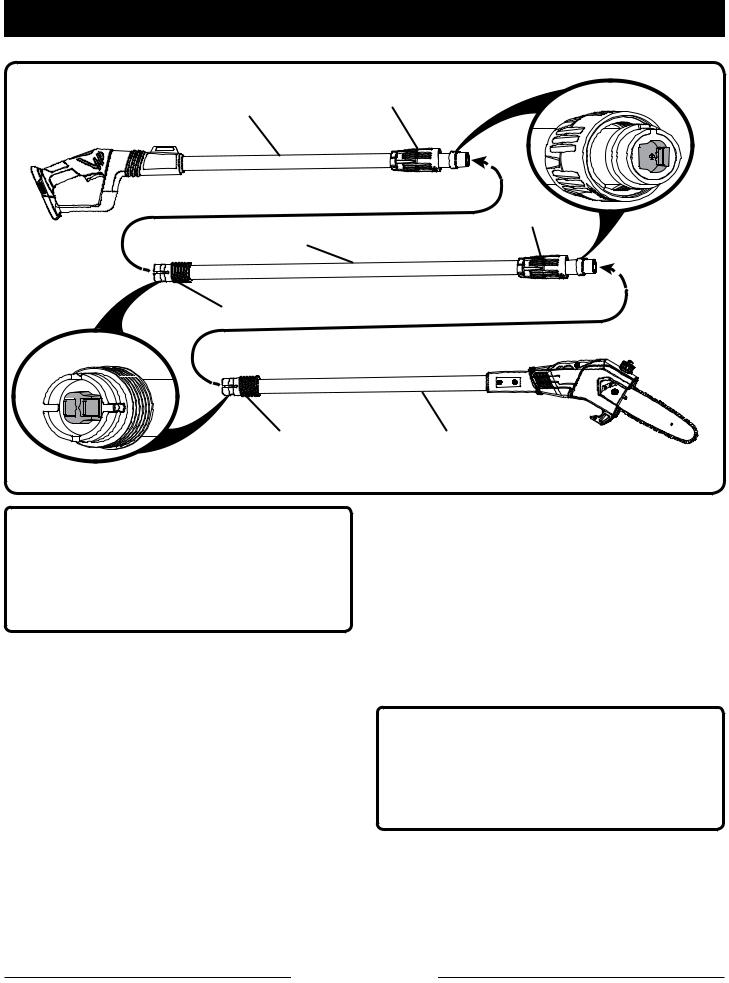
ASSEMBLY
handle |
collar |
socket |
pole |
|
|
collar
intermediate pole
threaded base
PLUG
threaded base
 WARNING:
WARNING:
To prevent accidental starting that could cause serious personal injury, always remove the battery pack from the product when assembling parts.
connecting the poles
See Figure 2.
nInsert the plug on the intermediate pole into the socket on the handle pole and push together until fully seated. The plug is larger on one side and will only install one way.
CUTTING head
pole
Fig. 2
nLower the collar on the handle pole to the threaded base on the intermediate pole and rotate clockwise to secure.
nRepeat this process to attach the intermediate pole to the cutting head pole.
NOTE: When assembled correctly, handle pole and cutting head pole should not be able to separate from intermediate pole when pulled. Repeat above steps if poles can be separated from intermediate pole.
 WARNING:
WARNING:
Failure to securely assembly and lock all poles together as directed above could cause the poles to separate and could result in serious personal injury or death.
Page 10 — English

ASSEMBLY
ATTACHING THE SHOULDER
HARNESS
See Figure 3.
n Connect the latches on the shoulder harness to |
|
|
|
the strap hangers. |
Latch |
|
|
n Adjust the strap to a comfortable position. |
Latch |
||
|
|||
|
strap |
|
|
|
hangerS |
Fig. 3 |
|
|
|
OPERATION
 danger:
danger:
Never cut near power lines, electric cords, or other electric sources. If bar and chain jams on any electrical cord or line, DO NOT TOUCH THE BAR OR CHAIN! THEY CAN BECOME ELECTRICALLY LIVE AND VERY DANGEROUS. Continue to hold the pole saw by the insulated rear handle or lay it down and away from you in a safe manner. Disconnect the electrical service to the damaged line or cord before attempting to free the bar and chain from the line or cord. Contact with the bar, chain, other conductive parts of the pole saw, or live electric cords or lines will result in death by electrocution or serious injury.
 WARNING:
WARNING:
Do not allow familiarity with this product to make you careless. Remember that a careless fraction of a second is sufficient to inflict serious injury.
 WARNING:
WARNING:
Do not use any attachments or accessories not recommended by the manufacturer of this product. The use of attachments or accessories not recommended can result in serious personal injury.
Before each use, inspect the entire product for damaged, missing, or loose parts such as screws, nuts, bolts, caps, etc. Tighten securely all fasteners and caps and do not operate this product until all missing or damaged parts are replaced. Please call 1-800-860-4050 or contact an authorized service center for assistance.
APPLICATIONS
You may use this product for the purposes listed below:
nLimbing
nPruning
 WARNING:
WARNING:
Always wear eye protection with side shields marked to comply with ANSI Z87.1, along with head protection. Failure to do so could result in objects being thrown into your eyes and other possible serious injuries.
Page 11 — English
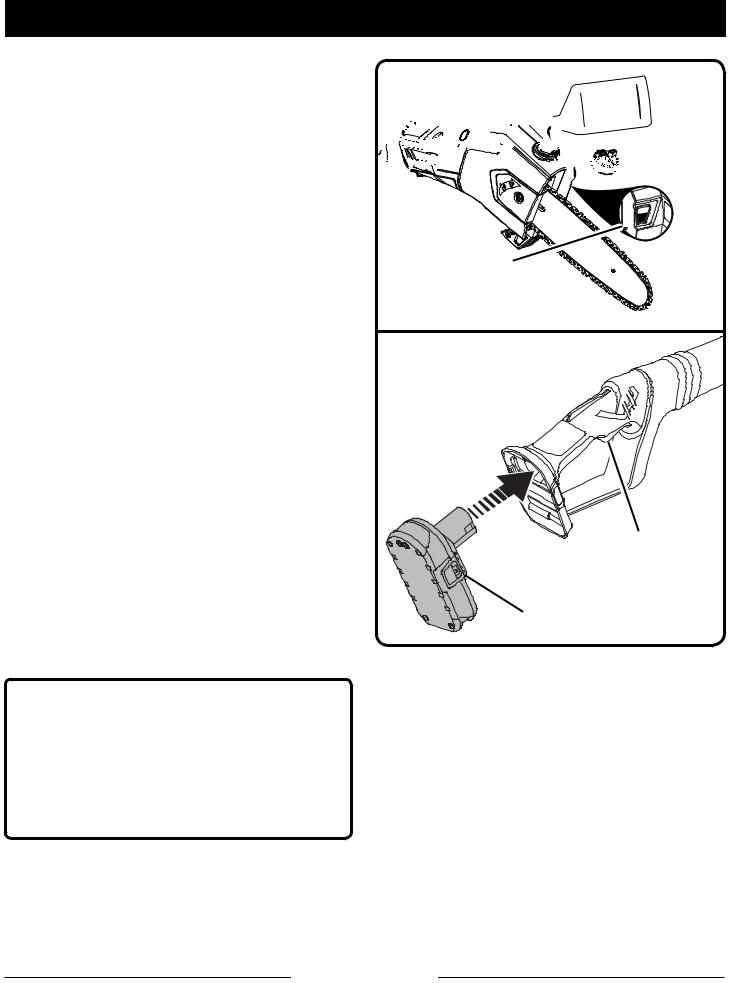
OPERATION
ADDING bar and chain lubricant
See Figure 4.
Use Bar and Chain Lubricant. It is designed for chains and chain oilers, and is formulated to














 perform over a wide temperature range with no
perform over a wide temperature range with no















 dilution required.
dilution required. 

























CHAIN
LUBRICANT








 cap
cap
Note: Pole saw comes from the factory with no bar and chain lubricant added. Level should also be checked after every 20 minutes of use and refilled as needed.
nRemove oil cap.
nCarefully pour the bar and chain lubricant into the bar lube reservoir.
nWipe off excess oil.
nCheck and fill the reservoir when quick view oil indicator is below the second to last indicator line.
nRepeat as needed.
NOTE: Do not use dirty, used or otherwise contaminated oils. Damage may occur to the bar or chain.
NOTE: It is normal for oil to seep from the saw when not in use. To prevent seepage, empty the oil tank after each use then run for one minute. When storing the unit for a long period of time (three months or longer) be sure the chain is lightly lubricated; this will prevent rust on the chain and bar sprocket.
quick view |
oil indicator |
Fig. 4
lock-out button 
switch trigger
TO INSTALL / REMOVE BATTERY |
BATTERY |
Fig. 5 |
PACK |
|
|
See Figure 5. |
To install: |
|
|
|
 WARNING:
WARNING:
Always remove battery pack from your tool when you are assembling parts, making adjustments, cleaning, carrying, transporting or when not in use. Removing battery pack will prevent accidental starting that could cause serious personal injury.
NOTE: To avoid serious personal injury, always remove the battery pack and keep hands clear of the lock-out button when carrying or transporting the tool.
nPlace the battery pack in the pole saw. Align raised rib on battery pack with groove in battery port.
nMake sure the latches on each side of the battery pack snap in place and battery pack is secured in pole saw before beginning operation.
To remove:
Locate latches on side of battery pack and depress both sides to release the battery pack from the pole saw.
Page 12 — English
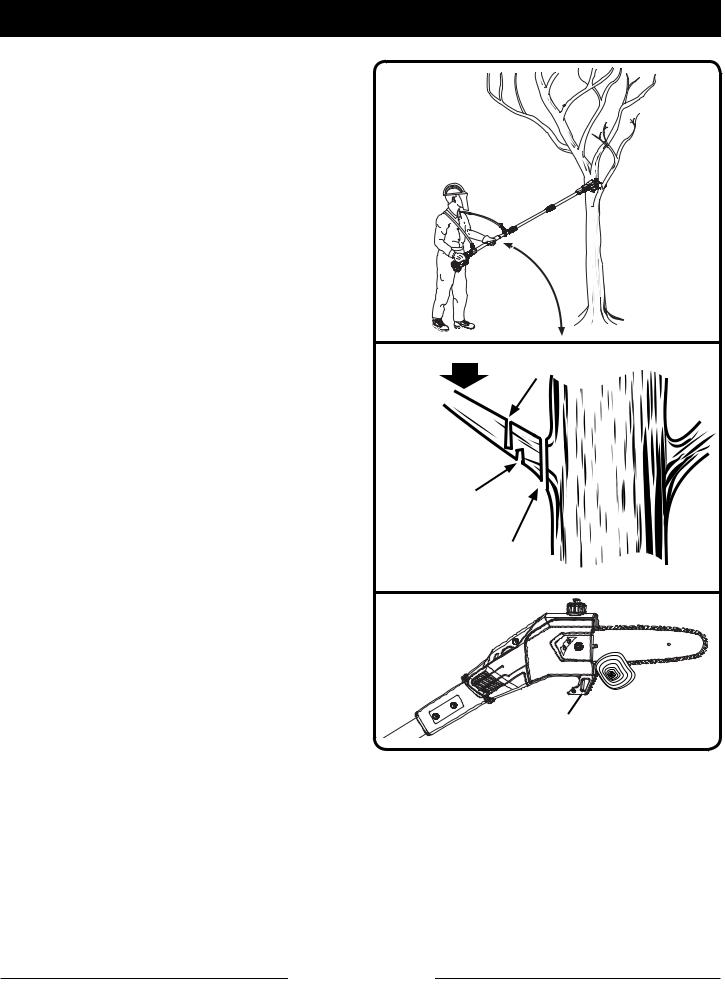
OPERATION
STARTING AND STOPPING
See Figure 5 - 6.
To start the motor:
nHold the pole saw as shown and ensure that you are well away from anything that may contact the blade.
nPress and hold the trigger lock-out.nDepress the switch trigger.
To stop the motor:
nRelease the trigger to stop the pole saw. Upon release of the trigger, the trigger lock will automatically reset to the locked position.
Preparation for Cutting
See Figures 7 - 8.
nWear non-slip gloves for maximum grip and protection.
nMaintain a proper grip on the unit whenever the motor is running. Use your right hand to firmly grip the rear handle while your left hand has a firm grip on the pole shaft.
nHold unit firmly with both hands. Always keep your left hand on the pole shaft and your right hand on the rear handle, so your body is to the left of the chain line. Never use a left-handed (cross-handed) grip, or any stance that places your body or arm across the chain line.
nNever stand directly under the limb you are cutting.
nBe certain the collars are fully tightened before operating equipment; check them periodically for tightness during use to avoid serious injury.
Basic Cutting Procedure
Follow the steps below to prevent damage to tree or shrub bark. Do not use a back-and-forth sawing motion.
nMake a shallow first cut (1/4 of limb diameter) on the underside of the limb close to the main limb or trunk.
nMake a second cut from the top side of the limb outboard from the first cut. Continue the cut through the limb until the limb separates from the tree. Be prepared to balance the weight of the tool when the limb falls.
Fig. 6
LOAD
Second cut
First cut |
|
1/4 diameter |
|
FINAL |
|
cut |
Fig. 7 |
|
Cutting Guide |
Fig. 8 |
|
n Make a final cut close to trunk.
NOTE: For second and final cuts (from top of limb or branch), hold front cutting guide against the limb being cut. This will help steady the limb and make it easier to cut. Allow chain to cut for you; exert only light downward pressure. If you force the cut, damage to the bar, chain, or motor can result.
nRelease the trigger as soon as the cut is completed.
Page 13 — English
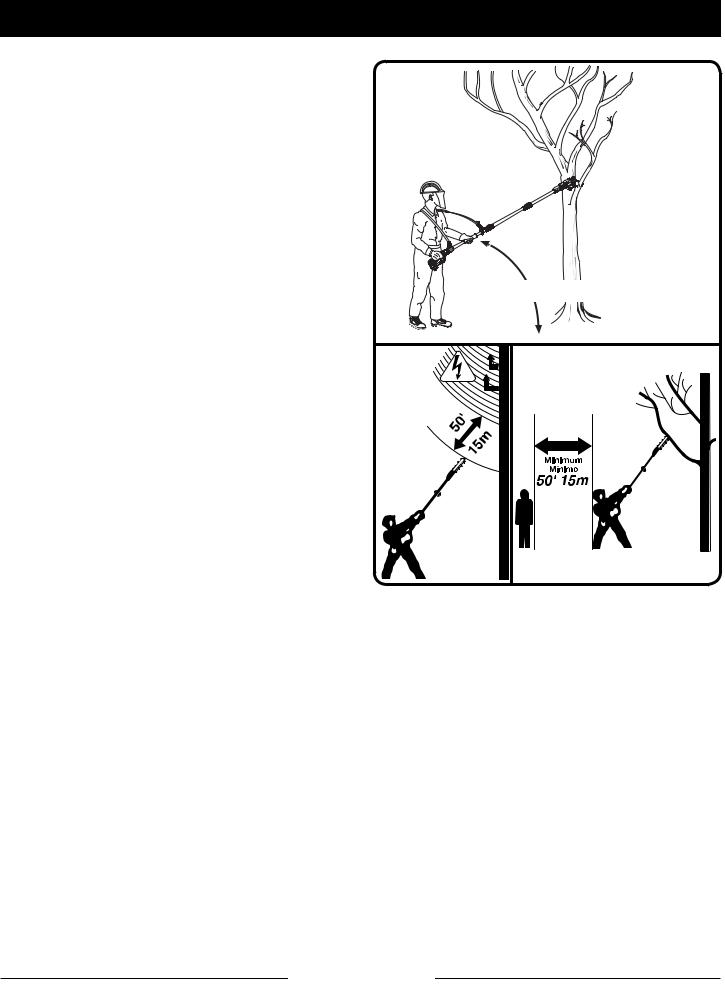
OPERATION
Failure to follow proper cutting procedures will result in the bar and chain binding and becoming pinched or trapped in the limb. If this should happen:
nStop the motor and remove the battery pack.
nIf the limb can be reached from the ground, lift the limb while holding the saw. This should release the “pinch” and free the saw.
nIf the saw is still trapped, call a professional for assistance.
Limbing and Pruning
See Figures 9 - 10.
This unit is designed for trimming small branches and limbs up to 6 in. in diameter. For best results, observe the following precautions.
nPlan the cut carefully. Be aware of the direction in which the branch will fall.
nBranches may fall in unexpected directions. Do not stand directly under the branch being cut.
nThe most typical cutting application is to position the unit at an angle of 60° or less, depending on the specific situation, as shown. As the angle of the pole saw shaft to ground increases, the difficulty of making the first cut (from the underside of limb) increases.
nRemove long branches in several stages.
nCut lower branches first to allow the top branches more room to fall.
nWork slowly, keeping both hands on the saw with a firm grip. Maintain secure footing and balance.
nKeep the tree between you and the chain while limbing. Cut from side of tree opposite branch you are cutting.
nDo not cut from a ladder; this is extremely dangerous. Leave this operation for professionals.
60° Maximum
Fig. 9
Fig. 10
nDo not make the flush cut next to the main limb or trunk until you have cut off the limb further out to reduce the weight. Following proper cutting procedures will prevent stripping the bark from the main member.
nDo not use the pole saw for felling or bucking.
nTo prevent electrocution, do not operate within 50 ft. of overhead electrical lines.
nKeep bystanders at least 50 ft. away.
Page 14 — English

maintenance
WARNING:
When servicing, use only identical replacement parts. Use of any other parts could create a hazard or cause product damage.
 WARNING:
WARNING:
Always wear eye protection with side shields marked to comply with ANSI Z87.1, along with head protection. Failure to do so could result in objects being thrown into your eyes and other possible serious injuries.
 WARNING:
WARNING:
Before inspecting, cleaning, or servicing the unit, stop the motor, wait for all moving parts to stop, and remove the battery pack. Failure to follow these instructions can result in serious personal injury or property damage.
GENERAL MAINTENANCE
Avoid using solvents when cleaning plastic parts. Most plastics are susceptible to damage from various types of commercial solvents and may be damaged by their use. Use clean cloths to remove dirt, dust, oil, grease, etc.
 WARNING:
WARNING:
Do not at any time let brake fluids, gasoline, petroleum-based products, penetrating oils, etc., come in contact with plastic parts. Chemicals can damage, weaken, or destroy plastic, which could result in serious personal injury.
All pole saw service, other than the items listed in these maintenance instructions, should be performed by competent pole saw service personnel. (For example, if improper tool is used to hold the flywheel in order to remove the clutch, structural damage to the flywheel could occur and subsequently could cause the flywheel to burst).
FLATS
Fig. 11
aPPROX .050 in. |
|
Fig. 12 |
|
Chain Tension
See Figures 11 - 12.
 WARNING:
WARNING:
To avoid possible serious injury, never touch or adjust the chain while the motor is running. The saw chain is very sharp; always wear protective gloves when performing maintenance to the chain.
nStop the motor and remove the battery pack before setting the chain tension. Make sure the chain cover screw is loose to finger tight, turn the chain tensioning screw clockwise to tension the chain. Refer to Replacing the Bar and Chain for additional information.
NOTE: A cold chain is correctly tensioned when there is no slack on the underside of the guide bar, the chain is snug, but it can be turned by hand without binding.
nChain must be re-tensioned whenever the flats on the drive links hang out of the bar groove as shown in fig. 11.
nDuring normal operation, the temperature of the chain will increase. The drive links of a correctly tensioned warm chain will hang approximately
.050 in. out of the bar groove, as shown in fig. 12.
Page 15 — English
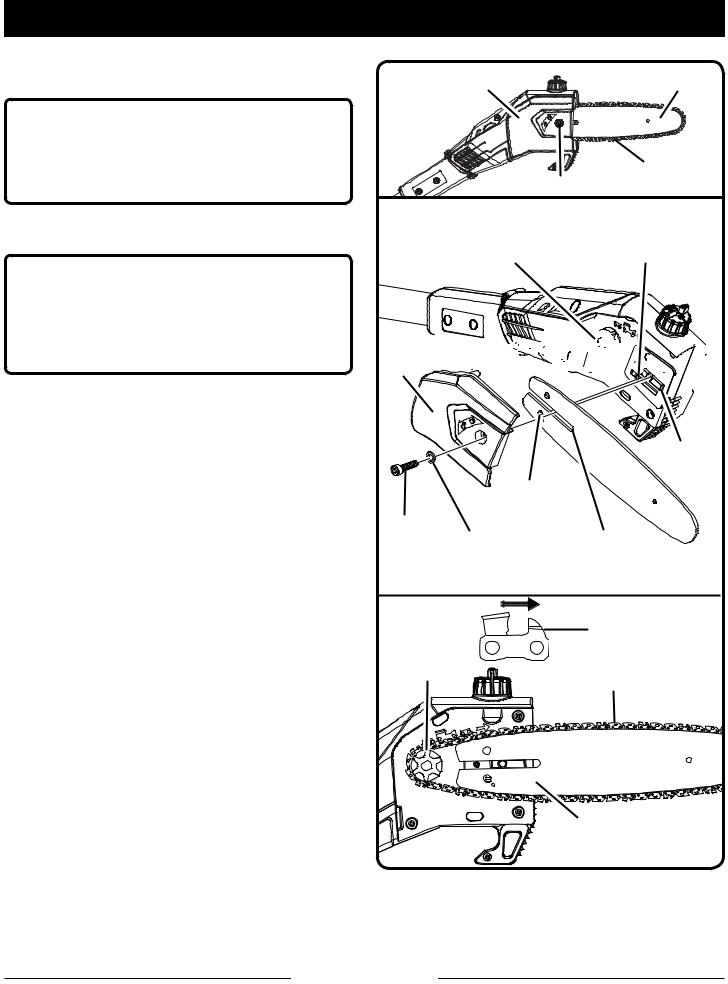
maintenance
NOTE: New chain tends to stretch; check chain tension frequently and tension as required.
NOTICE:
Chain tensioned while warm, can be too tight upon cooling. Check the “cold tension” before next use.
replacing the bar and chain
See Figures 13 - 16.
 WARNING:
WARNING:
To avoid possible serious injury, stop the motor and remove the battery pack before replacing the bar, chain, or performing any maintenance operation.
nUsing the hex key provided, remove the chain cover screw, washer, and chain cover from the chain saw.
nThe bar contains a slot that fits over the mounting post. The bar also contains a chain tensioning pin hole which fits over the chain tensioning pin.
nPlace the bar onto the mounting post so that the chain tensioning pin fits into the chain tensioning pin hole.
NOTE: If necessary, rotate the chain tensioning screw counterclockwise until the pin and hole can be aligned.
nFit the chain over the sprocket and into the bar groove. The cutters on the top of the bar should face toward the bar tip, in the direction of the chain rotation.
nReplace the chain cover and reinstall the washer and screw. Tighten the screw finger tight only. The bar must be free to move for tension adjustment.
nRemove all slack from chain by turning the chain tensioning screw clockwise, assuring that the chain seats into the bar groove during tensioning.
nTighten the chain cover screw securely.
NOTE: Chain is correctly tensioned when there is no slack on the underside of the bar, the chain is snug, but it can be turned by hand without binding.
chain |
|
BAR |
cover |
|
|
|
|
|
|
|
CHAIN |
chain cover screw |
Fig. 13 |
|
|
CHAIN |
|
SPROCKET |
TENSIONING PIN |
|
chain 















 COVER
COVER 




















|
|
MOUNTING |
|
|
|
BAR |
POST |
|
CHAIN |
|
|
|
|
|
|
|
TENSIONING |
|
|
chain |
PIN HOLE |
|
|
cover |
LOCK |
MOUNTING |
|
screw |
WASHER |
POST SLOT |
|
|
|
|
Fig. 14 |
|
|
CHAIN |
|
|
|
ROTATION |
|
SPROCKET |
CHAIN |
|
|
|
|
|
|
CHAIN |
TENSIONING SCREW |
Fig. 15
If chain is too tight, it will not rotate. Loosen the chain cover screw slightly and turn chain tensioning screw 1/4 turn counterclockwise. Retighten chain cover screw securely.
Page 16 — English

maintenance
Chain Oiler
See Figure 17.
n Use Premium Bar and Chain Lubricant. It is designed for chains and chain oilers and is formulated to perform over a wide temperature range with no dilution required.
n Remove the cap and carefully pour approximately 2 oz. of bar and chain lubricant into the bar lube reservoir.
n Replace the cap and tighten securely. |
|
|
|
n Check and refill the bar lube reservoir every time |
|
|
|
the pole saw is used. |
|
|
|
NOTE: Do not use dirty, used, or otherwise con- |
|
|
|
taminated lubricants. Damage may occur to the |
chain |
LOCK |
|
oil pump, bar, or chain. |
cover |
WASHER |
|
Chain Maintenance |
screw |
|
|
|
|
||
See Figure 18. |
|
Fig. 16 |
|
For smooth and fast cutting, the chain needs to |
|
||
|
|
||
be maintained properly. The following conditions |
|
BAR LUBE |
|
indicate that the chain requires sharpening: |
|
||
|
RESERVOIR |
||
n Wood chips are small and powdery |
|
||
|
|
||
n Chain must be forced through the wood during |
|
|
|
cutting |
|
|
|
n Chain cuts to one side |
|
REMOVE |
|
During maintenance of the chain, consider the |
|
CAP |
|
following: |
|
|
|
n Improper filing angle of the side plate can in- |
|
|
|
crease the risk of a severe kickback. |
|
|
|
n Depth gauge (or raker clearance) setting de- |
|
Fig. 17 |
|
termines the height the cutter enters the wood |
|
||
|
|
||
and the size of the wood chip that is removed. |
raker (depth gauge) |
||
Too much clearance increases the potential for |
|||
clearance |
|||
kickback. Too little clearance decreases the size |
|
|
|
of the wood chip thus decreasing the chain's |
|
|
|
cutting ability. |
|
.025 in. |
|
n If cutter teeth have hit hard objects such as nails |
|
||
|
|
||
and stones, or have been abraded by mud or |
|
Fig. 18 |
|
sand on the wood, have service dealer sharpen |
|
||
|
|
||
chain. |
|
|
|
Page 17 — English

maintenance
How to Sharpen the Cutters
See Figures 19 - 22.
Be careful to file all cutters to the specified angles and to the same length, as fast cutting can be obtained only when all cutters are uniform.
nTighten the chain tension enough that the chain does not wobble. Do all of your filing at the midpoint of the bar. Wear gloves for protection.
nUse a 5/32 in. diameter round file and holder.
nKeep the file level with the top plate of the tooth. Do not let the file dip or rock.
nUsing light but firm pressure, stroke towards the front corner of the tooth. Lift file away from the steel on each return stroke.
nPut a few firm strokes on every tooth. File all left hand cutters in one direction. Then move to the other side and file the right hand cutters in the opposite direction. Occasionally remove filings from the file with a wire brush.
Parts of a Cutter
Cutting
Top Corner
Plate
Side Plate
Rivet Hole 

 Depth Gauge
Depth Gauge
Heel |
Toe Fig. 19 |
Gullet |
Fig. 20
notice:
Dull or improperly sharpened chain can cause excessive motor speed during cutting which may result in severe motor damage.
 WARNING:
WARNING:
Improper chain sharpening increases the potential of kickback. Failure to replace or repair damaged chain can cause serious injury.
Fig. 21
LEFT HAND
CUTTERS
RIGHT HAND 


CUTTERS
Fig. 22
Page 18 — English
